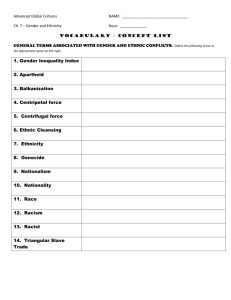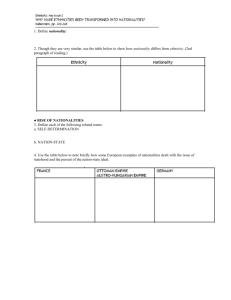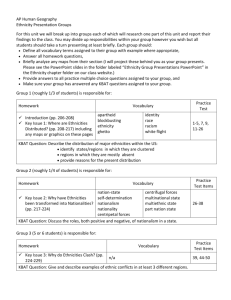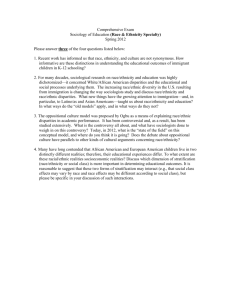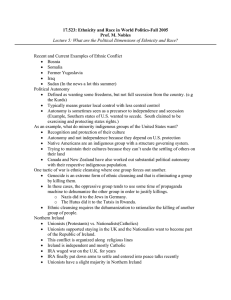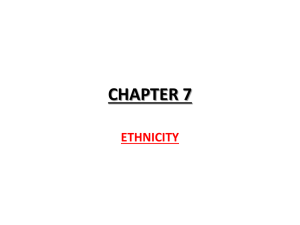REVIEW Questions for Chp. 7 Ethnicity Question 1: President
advertisement
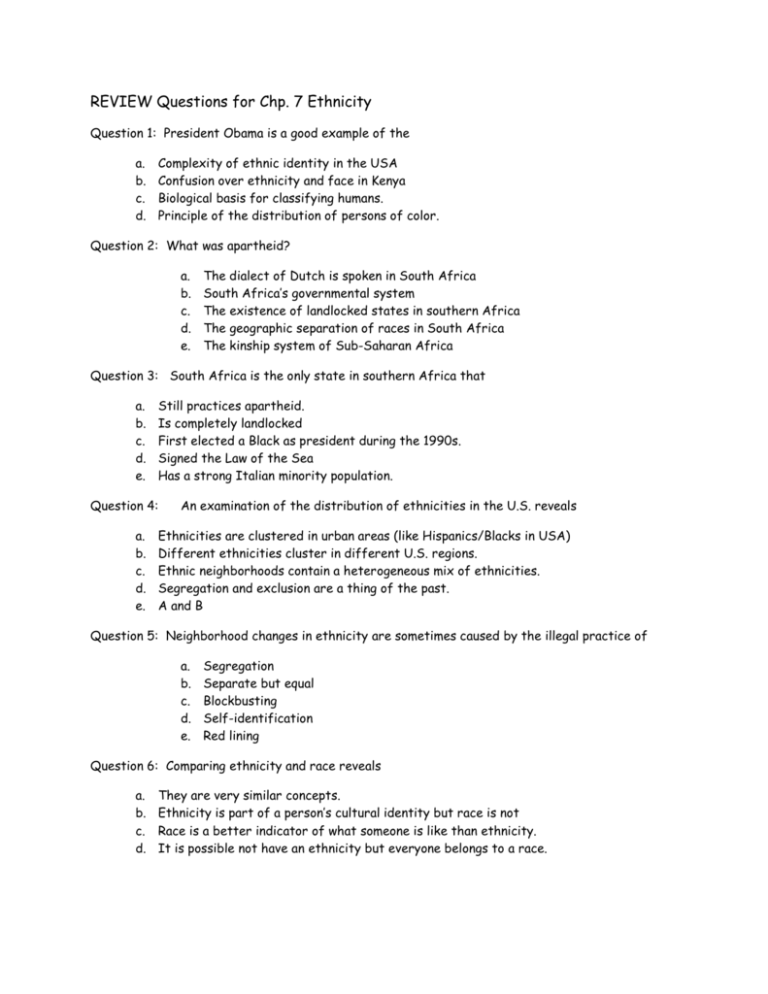
REVIEW Questions for Chp. 7 Ethnicity Question 1: President Obama is a good example of the a. b. c. d. Complexity of ethnic identity in the USA Confusion over ethnicity and face in Kenya Biological basis for classifying humans. Principle of the distribution of persons of color. Question 2: What was apartheid? a. b. c. d. e. The dialect of Dutch is spoken in South Africa South Africa’s governmental system The existence of landlocked states in southern Africa The geographic separation of races in South Africa The kinship system of Sub-Saharan Africa Question 3: South Africa is the only state in southern Africa that a. b. c. d. e. Still practices apartheid. Is completely landlocked First elected a Black as president during the 1990s. Signed the Law of the Sea Has a strong Italian minority population. Question 4: a. b. c. d. e. An examination of the distribution of ethnicities in the U.S. reveals Ethnicities are clustered in urban areas (like Hispanics/Blacks in USA) Different ethnicities cluster in different U.S. regions. Ethnic neighborhoods contain a heterogeneous mix of ethnicities. Segregation and exclusion are a thing of the past. A and B Question 5: Neighborhood changes in ethnicity are sometimes caused by the illegal practice of a. b. c. d. e. Segregation Separate but equal Blockbusting Self-identification Red lining Question 6: Comparing ethnicity and race reveals a. b. c. d. They are very similar concepts. Ethnicity is part of a person’s cultural identity but race is not Race is a better indicator of what someone is like than ethnicity. It is possible not have an ethnicity but everyone belongs to a race. Question 7: Balkanization refers to a. b. c. d. e. The creation of multi-national states The devolution of a state due to conflicts among nationalities A small geographic area that cannot successfully be organized into states Ethnic cleansing Exclaves and enclaves Question 8: The most centripetal force in Yugoslavia before its breakup was the a. b. c. d. e. Religion Language Number of nationalities Common economic interests like having the dinar as single monetary system Conflict with Turkey Question 9: United Kingdom is a a. Multinational state b. Nation c. Multiethnic state d. Nation-state Question 10: Which was not a religion of Lebanon? a. Druze b. Shiites c. Christians d. Arabs e. Sunnis Question 11: In the USA, which is shared by all Americans? a. Nationality b. Language c. Ethnicity d. race e. gender Question 12: West Bank, Golan Heights, and Gaza Strip form together as a a. Multiethnic state b. Nation-state c. Nation d. Multinational state Question 13: India was divided into 3 areas in 1947 by the British. East Pakistan is now called a. India b. Bhutan c. Bangladesh d. Nepal e. Pakistan Question 14: African Americans are clustered in what area of the United States? a. b. c. d. e. Southeast Southwest Midwest stages Pacific Northwest East Coast Question 15: The situation in Yugoslavia after the death of Tito included all BUT a. b. c. d. e. Muslims became persecuted Ethnicities began to claim land for their own. Military power was established. The dinar system of money was continued Ethnic cleansing occurred as Muslims were pushed to Albania Question 16: Which is the best example of a nation-state? a. USA b. United Kingdom c. Russia d. Germany e. Belgium Question 17: Nationalism is an important example of what kind of force? a. centripetal b. centrifugal c. balkanization d. self-determination e. ethnic cleansing Question 18: Ethnicity matters for all of the reasons listed except: a. Infant mortality rate b. life expectancy c. nationalism d. ethnic conflict within a country or there is none e. income Question 19: Which pair of concepts or entities from South Africa and the USA is the best match? a. apartheid – “Jim Crow” segregation laws b. homelands – blockbusting c. South African Nationalist Party – USA Supreme Court. Question 20: The colonial power of the 1800s and early 1900s for Eritrea/Ethiopia territory was: a. Belgium b. Italy c. United Kingdom/Great Britain d. Portugal e. Germany Question 21: The colonial power of the 1800s and early 1900s for the territory of India was: a. United Kingdom b. Germany c. Belgium d. Italy e. Netherlands Question 22: In 2016 Kashmir territory belongs to: a. Pakistan b. Bangladesh c. India d. Russia Question 23: The Kurds: a. are living in a new country created for them between Iraq, Iran, and Turkey b. are a group which long ago migration from Anatolia to the Balkans c. have no wish to become a nationality , only to remain an ethnicity d. have a large population but are divided among other countries where they are a minority in every one. ANSWER #1: A ANSWER#2: D ANSWER #3: C ANSWER #4: E ANSWER #5: C ANSWER #6: B ANSWER #7: B ANSWER #8: D ANSWER #9: A ANSWER #10: D ANSWER #11: A ANSWER #12: C ANSWER #13: C ANSWER #14: A ANSWER #15: D ANSWER #16: D ANSWER #17: A ANSWER #18: C ANSWER #19: A ANSWER #20: B ANSWER #21: A ANSWER #22: C ANSWER #23: D

